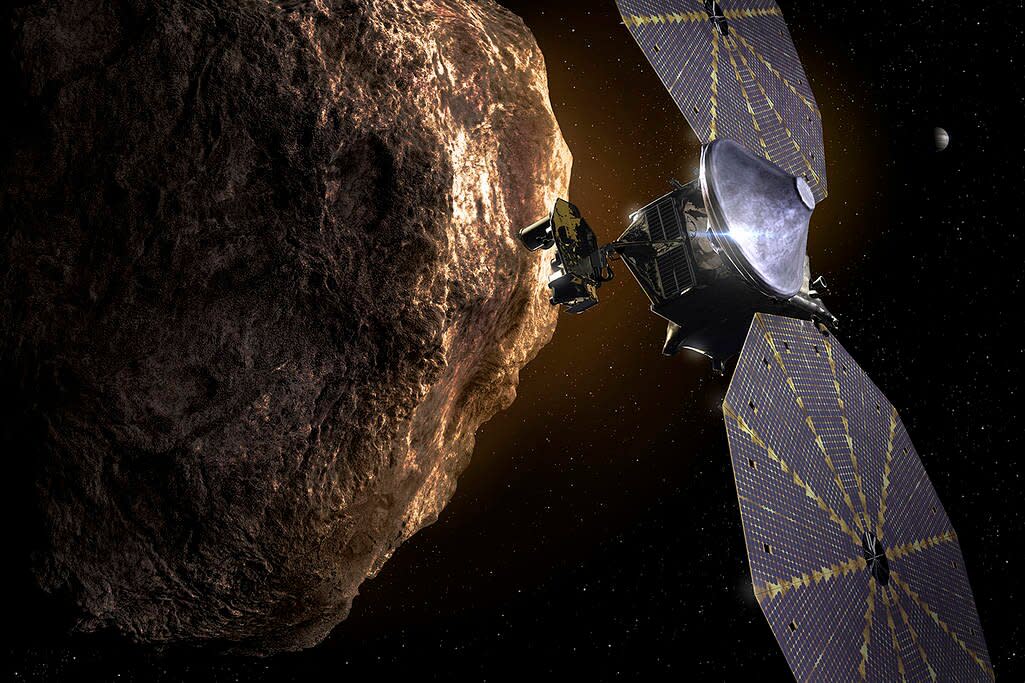NASA Spacecraft Named Lucy Skims Earth's Atmosphere on Its Way to Explore Asteroids Orbiting Jupiter

Southwest Research Institute
People around the globe spotted a bright light zipping through the sky on Sunday morning — but it wasn't a shooting star.
That light was NASA's Lucy spacecraft, which passed 200 miles above the Earth's surface during the one-year anniversary of its mission.
Lucy, which NASA says was visible around 7:04 a.m. ET, passed Western Australia and eventually the Pacific Ocean, giving Earth residents something to observe as the spacecraft was on its way to explore the Trojan asteroids orbiting Jupiter.
"In the original plan, Lucy was actually going to pass about 30 miles closer to the Earth," Rich Burns, Lucy project manager at NASA's Goddard Space Flight Center in Greenbelt, Maryland, said in a release. "However, when it became clear that we might have to execute this flyby with one of the solar arrays unlatched, we chose to use a bit of our fuel reserves so that the spacecraft passes the Earth at a slightly higher altitude, reducing the disturbance from the atmospheric drag on the spacecraft's solar arrays."
RELATED: NASA Astronaut Megan McArthur Reflects on 'Incredible' First Month (of Six!) on ISS: 'It's Fun'
Here's @LucyMission during today's Earth gravity assist. Screengrab from observations made by @plutoflag.
Tracking continues on https://t.co/u9JmKlOCQ3 pic.twitter.com/ZNBWjcYPhB— Raphael Marschall (@SpaceMarschall) October 16, 2022
In order to zip past our planet, Lucy had to navigate dense areas of satellites and debris, meaning special procedures had to be put in place to prevent any accidents, and to avoid a "potentially catastrophic collision," Coralie Adam, the team chief for the Lucy deputy navigation team from KinetX Aerospace, said.
"If the team detects that Lucy is at risk of colliding with a satellite or piece of debris, then – 12 hours before the closest approach to Earth – the spacecraft will execute one of these, altering the time of closest approach by either two or four seconds," Adam said.
Sunday morning marked the first of three total times Lucy is expected to zip by the Earth, as entering the planet's orbit will give it a boost to continue its mission, CNN reports.
RELATED: NASA Launches DART Mission to Collide with Asteroid: 'Turning Science Fiction into Science Fact'
Lucy, which is the main part of a $981 million mission, first hit the sky in October 2021, with a 12-year mission goal of exploring the Trojan asteroids, which have yet to be observed in the history of space exploration.
The exploration means Lucy may finally be able to provide the first high-resolution images of the asteroids. The spacecraft was named after Lucy, the fossilized human ancestor, which was named after The Beatles song, "Lucy in the Sky with Diamonds."
Never miss a story — sign up for PEOPLE's free daily newsletter to stay up to date on the best of what PEOPLE has to offer, from juicy celebrity news to compelling human interest stories.
One year ago today, a little spacecraft by the name of Lucy left this planet to go explore other worlds - and now, she’s back briefly for a gravity boost! 💫🚀She keeps getting me up in the wee hours of the morning for some reason, but she knows I’ll keep coming back for more. 😂 pic.twitter.com/rAn6jpsBQi
— Lauren Duda (@deepspaceduda) October 16, 2022
"I'm especially excited by the final few images that Lucy will take of the Moon," John Spencer, acting deputy project scientist at SwRI, said in the release. "Counting craters to understand the collisional history of the Trojan asteroids is key to the science that Lucy will carry out, and this will be the first opportunity to calibrate Lucy's ability to detect craters by comparing it to previous observations of the Moon by other space missions."
With Lucy's appearance in our atmosphere, people across the world were encouraged by NASA to share whatever images they can grab of the spacecraft flying above, using the hashtag, "#WaveToLucy."
#SpotTheSpacecraft update: The Lucy Team in Boulder and Littleton, Colorado were stuck with overcast skies, but two intrepid team members made a roadtrip to Scottsbluff, Nebraska and spotted Lucy with a telescope and shared what they saw. Whoot! #LucyMission#EarthGravityAssist pic.twitter.com/8LYhFBNdqp
— Lucy Mission (@LucyMission) October 16, 2022
"The Lucy Team in Boulder and Littleton, Colorado were stuck with overcast skies, but two intrepid team members made a roadtrip to Scottsbluff, Nebraska and spotted Lucy with a telescope and shared what they saw," the Lucy Mission Twitter account shared. "Whoot!"

